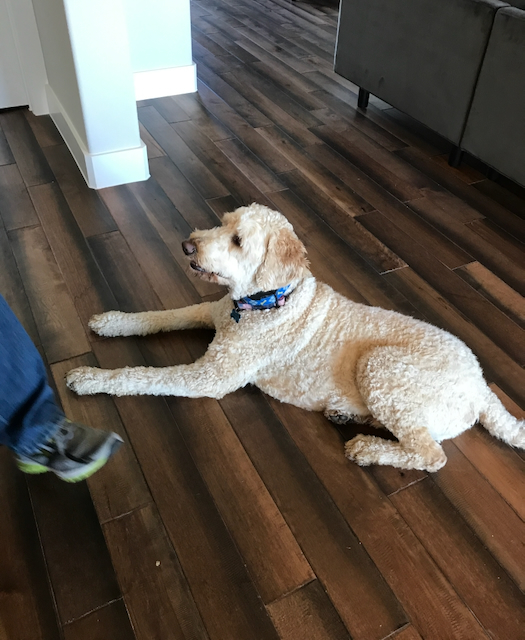Dog behavior problems come in all shapes and sizes. From relatively simple things like a dog that bolts out open doors, to difficult problems such as a dog that has bitten a family member or can’t live peacefully with another pet in the home. Frustrated dog owners are usually looking for immediate results. But it is rare that a quick fix, behavioral band-aid, will solve behavior issues.
Dog behavior problems are a complex mix of genetics, learned experiences, practiced habits, and sometimes underlying physical ailments. It takes effort to determine what contributing factors are at play. It also takes effort to create a plan for resolving the issue. After all that, you can finally begin implementing the plan!
That does not mean there isn’t hope to change a dog’s behavior. It just means that having a well behaved dog is a process. It is a process of doing little things day after day, and learning to do them successfully in order to build new habits.
There are two lifestyle modifications I recommend for anyone struggling with their dog’s behavior. These changes help almost immediately.
- Using a crate to manage the dog more effectively.
- Keeping a drag line on the dog while in the house. (A drag line is a leash with no handle or the handle cut open so it doesn’t get snagged.)
But I also suggest a third change. One that sets the tone for improving the relationship rather than just managing the problems. I encourage all dog owners to learn to “own space” within their household. This is a simple, daily act that primes the dog to be more willing to take direction.
Owning space is a leadership exercise. It requires your dog to move out of the way when you want to move through or use the space they are occupying. Dogs naturally understand the dynamics of spatial orientation. If you’ve ever watched dogs play, you’ve likely noticed how they use their body language to start and stop games. Or how they position their body if they don’t want to join in the play. If you’ve witnessed a dog give up a toy or his spot on the bed because another dog was using subtle body language to insist on it…you’ve seen how adept dogs are at communicating by owning or giving space.
Humans do the same things. We may squeeze tighter together to not let someone cut in line. We jockey for prime parking spots. But we also get out of the way for dignitaries. We hold doors open for others, and give up a seat to someone else.
Owning space is a sign of authority. Yielding space is a sign of deference.
Both behaviors are valuable in communicating. But when it comes to living with a dog, teaching the dog to relinquish space helps maintain a peaceful coexistence.
Here are ways you can incorporate owning space into your daily routine. *Note – if your dog behavior problems are serious or you see any sign of concern such as growling, baring teeth, or significant resistance, please seek a professional for help.
- Require your dog to move if they are lying in your way. Rather than going around or stepping over the dog, shuffle your feet “through” them so they must get up and relocate.
- If your dog bulldozes past you in stairwells or doorways, use a leash and body blocking techniques to teach them to effectively slow down, stay behind, or “wait” for you to pass through.
- Have your dog move off of their comfy spot on the couch so you can sit there. You don’t have to do this every time your dog is on the couch, but it is valuable to make them move on occasion.
- If you sleep with your dog and he/she is resistant about sharing space and moving over, it is time to take back that entitlement. Fido gets to sleep in his own bed (or crate) on the floor from now on.
- When you open the door of your dog’s crate, don’t let her bolt out. If the dog attempts to bolt, close the door quickly so she can’t rush out. Do this repeatedly, until the dog learns to wait and yield until you give them permission to come out of the crate.
- Don’t allow your dog to “push” you to do things quickly (barking, whining, pacing, pushing into you). Do the opposite. Move more S-L-O-W-L-Y to prepare the food, get the treat, or attach the leash. This teaches your dog he gets what he wants when he shows calm deference to you.
- Step TOWARD your dog if they are attempting to jump on you. Moving INTO the dog (rather than turning your back or moving away) takes up the space and communicates the right message.
Once your dog is willingly yielding space, you can begin to invite them to share it with you. Invite your dog onto the couch, invite your dog to jump up and give you a hug (if you wish), or invite your dog to push into you when playing your favorite game. There is far less drama in a household where the dog realizes you are the dignitary and they should step aside willingly. And the behavior really begins to shine when the dog realizes that by showing deference, they might gain an opportunity to get invited to the party!
You can get ahead of dog behavior problems by implementing these little changes into your daily routine.

Two days ago, I noticed that my dog was acting strangely as he bit my younger brother. I’m curious about his behavior because it was his first time. Thank you for the lifestyle modification. I love the idea of owning space. Your effort to provide this valuable information is greatly appreciated. I’ve definitely learned a lot from it.